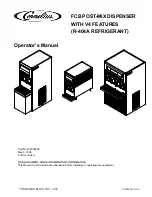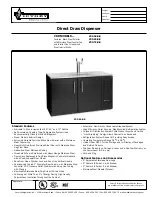
Viper Installation Manual
© 2010-2016, Cornelius Inc.
- 9 -
Publication Number: 621360041TBINS
Water Supply Requirements
NOTE: Water connections require 1/2” I.D. tubing. All hoses must reach the back of the unit plus
an adequate amount of extra tubing to allow the unit to be pulled out for servicing.
The Viper unit is designed as a high throughput unit. It is very important that the incoming water line is dedicated
to the unit. This line should not have any other machines connected which could cause a water surge, such as
coffee makers or ice machines.
!
IMPORTANT
:
The water supply should be consistent with proper water quality standards (neutral pH of 7.0 to 8.0), and should
not be connected to a water softener. Drink quality may be affected by poor water conditions. Water connections
should be sized, installed and maintained according to federal, state and local laws.
NOTE: Size, install, and maintain the water pipe, connections, and fixtures directly connected to
a potable water supply in accordance with Federal, State, and Local codes. It is the
installer’s responsibility to ensure that the potable water supply is equipped with
protection against backflow. This protection can be an air gap as defined by ANSI/ASME
A112.1.2-1979 or by an approved vacuum breaker or other approved method. If the
flowing water pressure at the back of the unit is less than the specified 25 psi and 100
GPH flowrate (per 2 barrels) a water pressure booster is required. It is recommended that
a water shutoff valve and water filter be installed in the water supply line.
Water Connections
Use the appropriate fittings and clamps to connect the water line to the unit. Run the tubing for the water (1/2 in.
ID, Min.) from the water source in the backroom to the unit and make all appropriate connections. Do not turn on
the water supply to the unit.
CO
2
Requirements
!
WARNING
:
CO
2
displaces oxygen. Persons exposed to high concentrations of CO
2
will experience tremors, followed by loss
of consciousness and death. It is very important to prevent CO
2
leaks, especially in small unventilated areas. If a
CO
2
leak occurs ventilate the area before fixing the leak.
NOTE: There are two CO
2
delivery systems available:
• High pressure Cylinder requires a Primary Regulator with a minimum inlet pressure of
500 psi.
• Low Pressure Bulk System requires a Secondary Regulator with a Maximum inlet
pressure of 200 psi.
NOTE: CO
2
connections require 3/8” I.D. tubing. All hoses must reach the back of the unit plus an
adequate amount of extra tubing to allow the unit to be pulled out for servicing.
NOTE: Two secondary regulators are required after the CO
2
supply. The dedicated secondary
regulator adjusted to 75 +/- 1 psig to supply the unit. It is highly recommended that this be
within 10 ft. of the unit and that the CO
2
source is not shared.
CO
2
Connections
Use a source-dedicated secondary regulator, fittings and clamps to connect the CO
2
line to the unit, as shown in
Figure 5. Set the regulator for 75 +/- 1 psig at the unit. Run the tubing for the CO
2
from the secondary regulator to
the unit and make all appropriate connections. Ideally, locate the regulator within 3 ft. of the unit. Another
secondary regulator is to be used to supply the Bag in Box pumps. It is to be set to 75 psig, not lower.
Do not
turn
on the CO
2
supply to the unit.
Summary of Contents for VIPER 3 FLAVOR
Page 35: ......














































